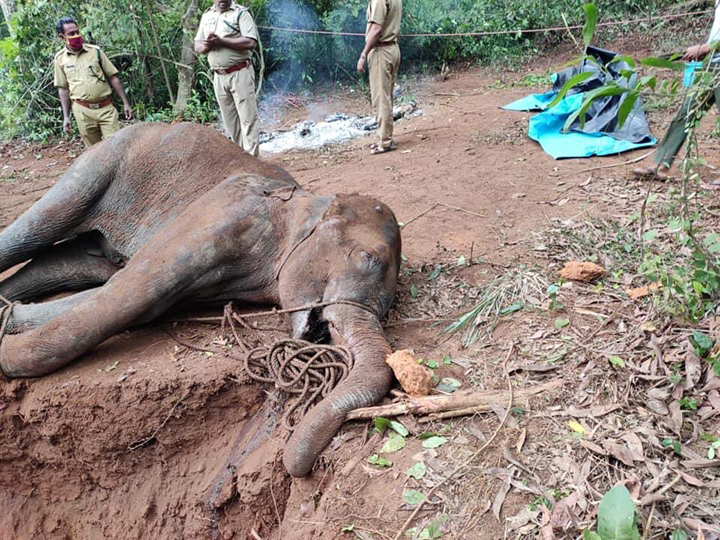Social media outrage over the death of a pregnant elephant cannot translate into better conservation unless stringent measures are taken to ensure the protection of natural habitat
The recent death of a pregnant elephant after eating a pineapple stuffed with firecrackers shocked the nation. This issue received global attention on social media, with people from all walks of life expressing shock. Politicians even tried communalising the issue by manipulating details of the incident.
Subsequent reports confirmed that the stuffed pineapple was bait meant for wild boars being culled by farmers to protect their crops and the elephant was the unintentional victim. Still, culling in such a gruesome way is problematic.
An age-old problem, the conflict between humans and wildlife occurs when a wild animal is considered a threat to livelihood and security of humans. The major reason for such conflicts is the loss of habitat due to human encroachment and as human activity increases in and around forested areas, the risk of wild animals entering cities and attacking humans and domesticated animals increases.
This is the very reason why elephants enter human-territory, raiding crops, which makes them a target for the local human population. Last year, Minister of State, Ministry of Environment, Forest and Climate Change (MoEFF) Mahesh Sharma presented data that in 2015-2018, human-elephant conflict resulted in 1,713 human and 373 elephant deaths of unnatural causes, including electrocution and poaching. In 2018 alone, 227 people were killed by wild elephants in 16 States with Assam reporting the highest number, 86.
Mahesh Rangarajan, Chair of Elephant Task Force 2010, also says, “Every year, more than 100 elephants are killed, out of which 50-60 are killed by farmers protecting their crops.”
Experts, therefore, point toward an alarming number of such cases. They blame urbanisation and development projects for destroying jungles and polluting pristine rivers.
Elephants were declared national heritage animals in 2010. The pachyderms are also protected under Schedule I of the Wildlife Protection Act, 1972. As per a recent census, there are 27,000 wild elephants in India, including those found in the Andaman and Nicobar Islands. Out of these, around 2,500 live in captivity. That means 60% of Asia’s and 50% of the world’s elephants live across 18 states in India. In the Southern states of Andhra Pradesh, Tamil Nadu and Karnataka are home to the maximum numbers of these elephants.
The recent death of the elephant evoked emotional reactions, Environment Minister Prakash Javadekar even said that killing of elephants is against the India culture. “Central Government has taken a very serious note of the killing of an elephant in Malapuram, Kerala. We will not leave any stone unturned to investigate and nab the culprit(s). It’s not Indian culture to feed firecrackers and kill,” he tweeted. (The incident took place in Palakkad district though.)
Despite all the outrage, the Ministry of Environment seems to be in a hurry to pass large-scale mining, infrastructure and industrial projects after the environment, forest and wildlife clearances by conducting video meetings of expert panels. As per reports around 200 projects are under consideration. These projects can result in the loss of habitat for elephants and require adequate time for officials to consider and assess their impact on the environment.
Expert panels like the National Board for Wild Life, the Forest Advisory Committee and 10 Expert Appraisal Committees are required to give green clearances to the Ministry of Environment, Forest and Climate Change.
The National Board for Wild Life (NBWL) recently allowed coal mining in elephant reserves in Assam during this lockdown, which was later suspended on 3 June due to widespread protest — giving the impression that despite all the pious statements, the government prioritises development over environment.
N Kalaivanan, veterinarian and elephant expert, while talking to the Hindu, said that the policymakers should make policies considering specific geographic locations since habitat degradation is a major factor behind elephant deaths. He explains this with the example of the compact landscapes of Nilgiris that provide “little space for interaction between wild elephants and people…disturbed landscapes, like Thevaram in Tamil Nadu’s Theni district, are linear forests and hence lead to issues such as crop raiding and human deaths.”
A senior IFS officer at Delhi forest department demanded serious efforts toward scientific restoration of habitats. He said, “Habitat loss is the real cause behind the man-elephant conflict. People blame farmers but the blocking of natural wildlife corridors for construction activity and creating tourist resorts have seriously affected the free movement of wild animals in their own natural habitats. Now the only solution lies in the scientific restoration of habitats.”
Loss of habitat that results in the death of these majestic, intelligent animals should be taken as a wake-up call. Since elephants are endangered, policy interventions are required to improve the health of ecology and reduce unnecessary deaths that could imbalance the fragile ecological ethos and beauty of the country.





